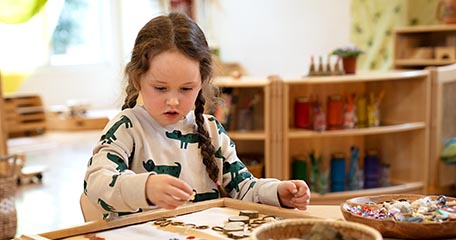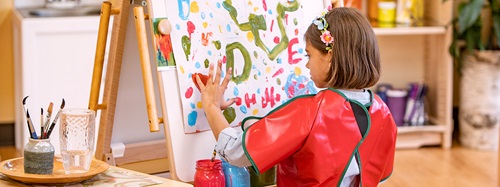Encouraging creativity and independence
| April 2012Sonia is four. This morning she went to the art corner and surveyed the possibilities. After some minutes, she selected a short length of blue wool, bringing it to the table. Her teacher quietly observed, wondering what Sonia had in mind. Next Sonia found the paper punch and a sheet of A4 paper. Carefully she punched a border of holes about an inch from the edge of the paper. After scrutinising the outcome with a critical eye, she began to thread the wool through the holes. Oh dear, it was not long enough! Sonia got another piece of wool (yellow, this time), which she painstakingly tied to the first bit. In the end, Sonia had used five segments of wool, each a different colour, to thread in and out making a border she was proud of. Only when she reached the last hole and was puzzled how to finish, did she turn to her teacher for help. The teacher thought Sonia was done, but no – she swapped her paper punch for a pair of scissors, a tube of glue, and a brochure advertising children’s books. She leafed through the catalogue until she had chosen the pictures she liked best, which she carefully cut out and glued to her wool-adorned paper. She held the result at arm’s length, studying the outcome with obvious satisfaction. While Sonia had been absorbed in her project, two friends watched; before Sonia’s work was complete, they too were punching holes and threading wool.

Loris Malaguzzi of Reggio Emilia wrote that children are not “excessively attached to their own ideas, which they construct and reinvent continuously. They are apt to explore, make discoveries, change their points of view…” Creativity should not be considered a separate mental faculty but a characteristic of our way of thinking, knowing, and making choices.
‘Our task, regarding creativity, is to help children climb their own mountains, as high as possible.” One need not be an artist to “teach” art to children; one only need dare experiment with them. Share ideas, offer materials and support, and have fun!
Art is not separate from other areas of learning; rather, it stretches the mind and helps us learn to think. As children explore texture, shape, quantity, and proportion, they are grasping concepts intrinsic to maths and literacy, and the fine-motor skills and eye/hand coordination learned with artwork underpin future writing. Emotionally too, creative activity gives children confidence, joy, and freedom – qualities that build healthy self-esteem.
Young children are active learners who gain new skills and insights best through hands-on experience. Offering children choice of activities and materials strengthens their decision-making ability. These principles, along with the tenet that “the process is more important than the result,” are fundamental in the field of creative art, where we want children to express themselves freely.
Inspiration for others
Children work at their inventive activities alone or with others. Working opposite or adjacent to one another at easel or table, they frequently inspire each other, and the Art Area becomes a happy social place. This is when adults may need to refrain from offering too much guidance. It is infinitely more exciting for a child to discover what happens when blue and yellow paint mix, than to have this fact stated or demonstrated by an adult.
Although the joy and satisfaction of creating is paramount – at this age, there is no division between work and play – the end product too can bring pleasure not only to the children but to others as well, since something of the spirit of childhood is captured in their artwork. It is remarkable how a child’s drawing or painting can lift the day of an elderly person, for example.
Easy access
You’ll want to display art supplies in such a way that children can see all their choices and access materials themselves. Offer a smorgasbord that will whet children’s creative appetites – not only commercial products, but a variety of natural and found materials as well. Some examples follow to stimulate your thinking, but you will doubtless add to the list.
Art materials to collect
To use as a base for projects
- Paper of various types
- Sandpaper
- Paper sacks
- Cardboard
- Aluminium foil
- Wax paper
- Wood (including drift wood)
- Styrofoam
- Toilet paper cylinders
- Shoe boxes
- Egg cartons
- Coffee filters
To cut
- Wrapping paper
- Wallpaper
- Old magazines
- Crepe paper
- Streamers
- Post cards
- Cereal boxes
- Birthday cards
- Straws
- Place mats
- Spaghetti
- Paper plates
For construction and collage
- Toothpicks
- Fabric
- Toilet paper cylinders
- Telephone wire
- Bottle caps
- Small boxes
- Pipe cleaners
- Paper towel cylinders
- Empty cotton reels
- Jar lids
- Eggshells
- Flowers
- Paper clips
- Sponges
- Pebbles
- Leaves
- Driftwood
- Shells
- Fir cones
- String
- Cotton wool
- Buttons
- Yarn
- Plasters
Alternatives to paint and finger-paint
- Water
- Liquid starch and glitter
- Food colouring and water
- Hair gel
- Watery glue and sawdust
- Shaving cream
- Corn flour
- Soap flakes
- Wet sand
- Cold cream
- Hand lotion
- Mud
To add to finger-paint
- Sawdust
- Liquid starch
- Lemon or peppermint extract
- Liquid soap
- Sand
- Candle scent
- Dry dirt
- Oil
- Shampoo
Alternatives to brushes
- Sponges
- Feather dusters
- Paint rollers
- Leaves
- Bottlebrushes
- Chopsticks
- Pot scrubbers
- Evergreen branches
- Squeeze bottles
- Straws
- Swabs
- Eyedroppers
- Toothbrushes
- Whiskbrooms
- Cotton wool
- Roll-on bottles
- Dish mops
- Fly swatters
For printing
- Wood scraps
- Buttons
- Bottle caps
- Empty reels
- Corks
- Leaves
- Linoleum scraps
- Rocks
- Shells
- Dominoes
- Toy cars
- Coins
- Cookie Cutters
- Hands, fingers, and toes
- Sponge shapes
To use with play dough
- Plastic knives
- Pizza cutter
- Bottle caps
- Cookie cutters
- Garlic press
- Buttons
- Scissors
- Popsicle sticks
- Clothespins
- Spatula
- Toothpicks
- Coins
- Rolling pin
- Twigs
- Flowers
- Potato masher
- Shells
- Leaves
Drying and cleaning up
When children have completed a project, they may need to dry it. Some centres have clotheslines and pegs to hang paintings, the drawback being that paint drips. Horizontal drying is preferable but can consume a lot of space. A drying unit with racks that children can access themselves is useful, especially if space between racks can be adjusted to accommodate 3D models (dough, clay, wood, papier-mâché, …) as well as paper.
After the activity comes cleanup! If materials are stored at child level in clearly labelled or transparent bins, it will be easy for children to return unused bits. And if the Art Area is located near a sink with buckets and rags stored within children’s reach, they will quickly learn the cleanup process, which can be as enjoyable as the activity itself.
The art area must provide space to display children’s work. Paintings, drawings, and photos of the creative process can be fastened to pinboard panels at child height, and tables or shelf-tops can accommodate constructions and sculptures. I know a teacher who makes kiosks from cardboard boxes to exhibit artwork. By displaying their efforts, we empower children and acknowledge the value of their work. They certainly enjoy rediscovering their creations next day, which often leads to further exploration.
When we give children scope and freedom, they discover unique approaches. I enjoyed a student’s story about one child using an easel the conventional way, while simultaneously another child was within the easel, painting on the inside! So keep your eyes and mind open for all the options – such as bringing art equipment outdoors – and your children will engage eagerly in creative work/play. To quote once more from Loris Malaguzzi “[Adults] must realise how listening to children is both necessary and expedient. They must know that activities should be as numerous as the keys of a piano, and that all call forth infinite acts of intelligence when children are offered a wide variety of options to choose from.”
If preschool children are given ample opportunities for innovative experimentation, they may extend their interests as they grow. In later years they may branch into constructive hobbies – weaving, pottery, metal or woodwork, sewing, watercolour painting, calligraphy… Conversely, if young children are not allowed to experiment freely, they may feel insecure and inhibited (fearful of making mistakes) in later years, and thus be prevented from free expression and discovery of their potential. We want them to climb their mountains – as high as possible!





